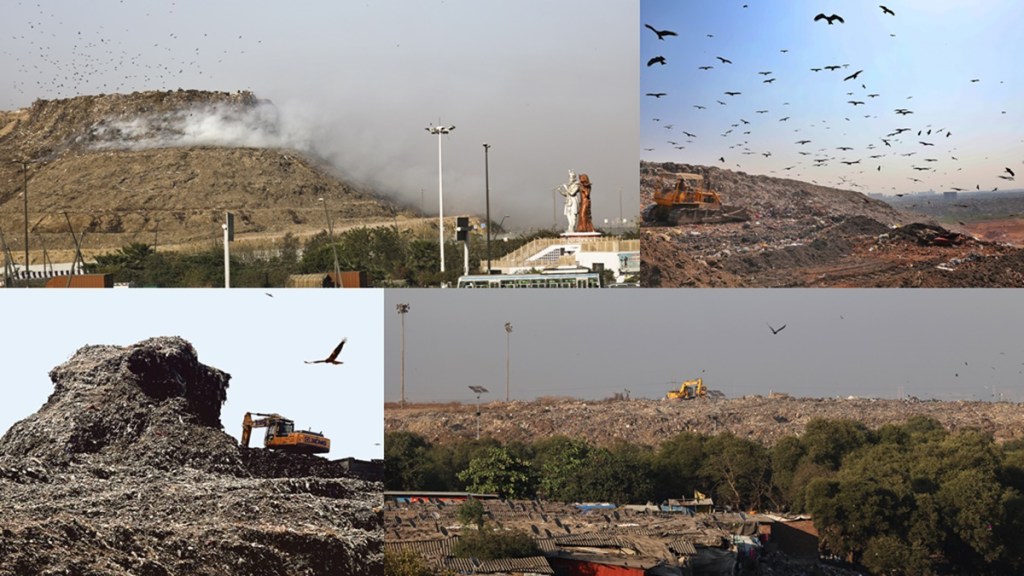The Ghazipur landfill in east Delhi is a picture of neglect and apathy. Every day, trucks arrive at the site to unload fresh heaps, even as a mountain of waste, nearly as tall as Qutub Minar, continues to grow and excavators struggle to prevent ‘collapses’. In the vicinity, the Vinod Nagar Metro Depot looks discomforting amid the black and grey hues of the garbage in the backdrop. Some commuters along the adjoining Delhi-Meerut expressway wear masks or tie a handkerchief around their faces, in a failed attempt to fight the stench, while others pass by, indifferent to the grim reality. People in nearby Indirapuram and Vaishali have to live with the stench, while the glass building of a prominent hospital on the opposite side reflects the very crisis it cannot treat—an urban nightmare.
Established in 1984, Ghazipur is one of the oldest and largest landfills in the national capital. It covers an area of approximately 70 acres (28 ha) and reaches heights of over 236 feet (72 m). Sadly, it also symbolises an insurmountable problem— India’s growing solid waste crisis.
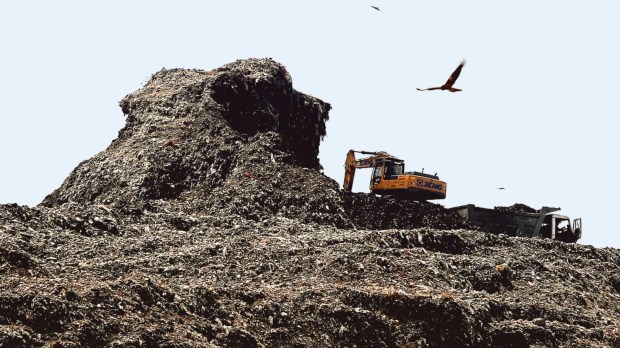
According to the Solid Waste Management Rules 2016, landfills are expected to be functional for 20-25 years, but the Ghazipur landfill is more than 40 years old. It crossed the 15-ft mark in 2002 and was meant to be shut down. Twenty-three years on, it continues to function because there are no alternative sites.
According to the 2023-2024 annual report on solid waste management in the national capital, uploaded on the Delhi Pollution Control Committee’s website, 11,342 tonne per day (TPD) of solid waste are collected, of which 7,542 TPD are processed or treated, which accounts for 66.5% of the total waste generated, and 3,800 TPD are dumped (accounting for 33.5%) at the three existing dumpsites of the city—Bhalswa, Ghazipur and Okhla.
In 2019, the National Green Tribunal directed to carry out bio-remediation of the dumpsites by installation of trommeling machines for screening of the legacy waste. In five years—from July 2019 to April 2024—of the total 140 lakh metric tonne (MT) of legacy waste at Ghazipur (the largest dumpsite of the three), only 25 lakh MT (17.9%) have been bio-mined. In comparison, work at Bhalswa has been reportedly the fastest among the three—of the 80 lakh MT of legacy waste, 63.42 lakh MT (79.3%) have been biomined. At Okhla, of the 60 lakh MT of legacy waste, 43.12 lakh MT (71.9%) have been bio-mined.
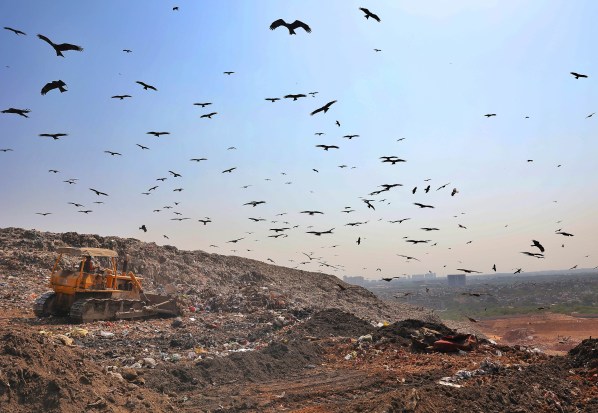
According to experts, assuming the current pace of biomining, more than three decades would be required to decongest Ghazipur alone—even without considering fresh waste arrivals on a daily basis. “Whatever target was set, we are still going very slow on that. So a more concerted approach needs to be followed,” says Suneel Pandey, director of the environment and waste management division at The Energy and Resources Institute (TERI).
In spite of government initiatives, Ghazipur is a classic example of India’s failure in solid waste management. “If we are not drowning in our own waste, it is only because of waste pickers,” offers Siddharth G Singh, programme manager, solid waste management, Centre for Science and Environment (CSE). “Delhi’s problem is also very closely linked to the issue of non-segregation of waste,” he adds.
Now that’s rubbish
India produces more than 1,70,000 MT of solid waste every day, of which around 90% are collected and 53% processed or recycled. About 24% are dumped at landfills, as per the Central Pollution Control Board’s (CPCB) latest report.
Delhi alone produces more than 11,000 MT of solid waste every day. Mumbai comes close with 7,000-7,500 MT per day, followed by Chennai at 5,400 MT per day, Kolkata at 4,500 MT, Ahmedabad at 4,200 MT, and Pune at 2,200 MT. Bengaluru contributes 5,000 MT, while Chandigarh, Guwahati, and Imphal contribute 500, 550, and 130 MT, respectively.
Singh of CSE points out the central problem: “People don’t segregate waste at the source. We want everything to be convenient—10-minute deliveries, single-use packaging, and plastic bags.” But there’s a price to be paid for convenience. Unless we begin separating trash at home, landfills will continue to expand, and recycling can never make up for our lack of effort at the point of generation, he adds.
Pandey of TERI concurs, “The biggest challenge is changing consumer behaviour. Even when segregation is mandated, compliance is low, making waste processing an uphill task.”
A free-flowing menace
Despite efforts by municipal corporations, waste processing remains inadequate. A significant portion of the waste collected in cities ends up in massive dumping yards —landfills that continue to expand beyond capacity. Mumbai produces around 7,000-7,500 MT of waste per day, 80% of which are sent to Kanjurmarg, and the remaining to Deonar. Opened in 1927, Deonar measures 311 acres and contains more than 20 million MT of trash, often releasing poisonous gases and posing risk to residents in the vicinity. Last year, the Maharashtra government reportedly made a controversial cabinet decision, allocating a 124-acre portion of the dumping ground to the Adani Group for housing units as part of the proposed Dharavi Redevelopment Project (DRP)—despite criticism of the state’s failure to address environmental concerns.
In Chandigarh, two legacy waste mountains of 5 lakh MT and 8 lakh MT, respectively, have come up in the past decades as a result of inadequate waste processing facilities. After missing repeated deadlines, Chandigarh municipal corporation has completed the bioremediation of two legacy waste dumps at Dadumajra landfill. The civic body officials say the freshly dumped waste or the third mountain, holding a massive 1.25 lakh MT of waste, at the landfill remains and work has started to process the waste.
Chennai’s Perungudi and Kodungaiyur dumpsites receive thousands of tonne of garbage daily, causing severe groundwater contamination. Kolkata’s 60-acre Dhapa dumping ground, functioning over capacity since 1987, continues to take more than 4,000 MT of waste on a daily basis. Bengaluru’s 50-acre Mittaganahalli landfill accepts more than 3,200 MT of mixed waste each day. Villagers have been opposing dumping the garbage in their backyard because of stench and groundwater contamination, polluting the surrounding lakes, killing fish, losing their cattle, along with health issues like breathing problems and skin irritation. In January this year, the Bangalore Solid Waste Management Limited (BSWML) estimated that 3,074 million litres of leachate at the Mittaganahalli and Kannur landfills will require four years and Rs 553 crore for treatment.
Similarly, Ahmedabad’s 84-hectare Pirana site has been bearing the burden of the city’s waste since 1982, estimated to have over 1.25 lakh MT of waste dumped in the last four decades in 2023. In May 2024, it was reported that 40 acres of the dumpyard had been cleared after multiple extensions in deadlines.
The Swachh Bharat Mission (SBM) Urban 2.0, which was initiated in 2021, has the objective of closing down all legacy landfills by 2025-26. At the time of writing this report, of 2,423 legacy landfills, 715 (29%) in 35 states and Union Territories have been remediated so far, releasing 4,077.93 acres of land, and efforts are in progress at 1,166 dumpsites, as per the SBM dashboard.
What about recycling?
The main barrier is good sorting of the waste. Preprocessing can only happen at the material recovery facilities (MRFs), experts say. Informal sector is important here. “For any material recovery facilities to operate in any city—a lot of this recyclable waste is removed by the informal sector,” says Pandey of TERI.
Leaving them out renders MRFs economically unsustainable. “You have to try to incorporate the informal sector into operations so that both gain,” he adds. “If you keep them away from the business model of material recovery facilities, they will never be financially viable.”
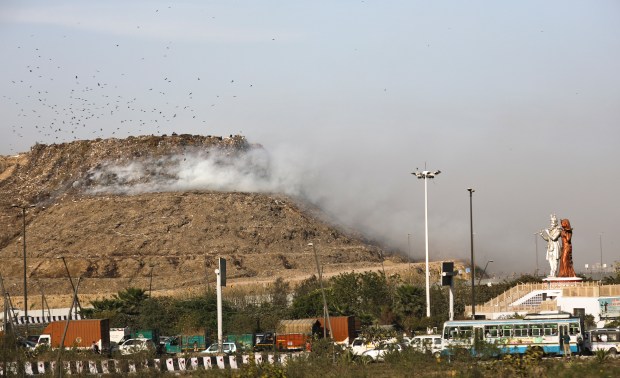
A 2023 study by Commonwealth Scientific and Industrial Research Organisation (CSIRO), TERI, Council of Scientific and Industrial Research-National Environmental Engineering Research Institute (CSIR-NEERI), Development Alternatives, the University of New South Wales and the University of Technology Sydney’s Institute for Sustainable Futures finds that India recycles just 8% of plastic waste. In the event of business as usual, recycling capacity would increase to merely 11% by 2035, and plastic consumption would reach 70.5 metric tonne from the present 24.1 MT. The report reads, “India often reports recycling rates for plastics of 60 to 70%, which may be true of some valuable plastics. However, the comprehensive material flow account (MFA) of plastics undertaken for this study determined a total circularity rate of 8% in 2019—that is, only 2 MT of the 24.1 MT of plastic consumed is returned to another use.” Notably, single use plastic use was banned in 2022 but reports say its implementation in markets remains a myth.
Recycling is not viewed as sustainable. Singh of CSE points out two main issues—product design modification and market demand. “We are shifting from rigid packaging, which could be reused or recycled, to flexible, composite, complex formats… which do not have one incentive to collect,” he explains. Even when collected, such plastics do not have a recycling market, with customers concentrated in sparse and few regions.
Having no resale value, consumers have little incentive to sort waste, resulting in material commingling. “Plastic is mixed with paper, metal, glass, organic waste… and when it gets to municipal collection, separation involves human effort, which comes at a cost,” Singh says.
Trashing health, environment
The health effects of this crisis are dire. Research indicates that people living around landfills have increased rates of respiratory illnesses, skin infections, and gastrointestinal diseases. The Ghazipur landfill had a fire last summer, releasing thousands of people living along the Delhi-Meerut expressway to poisonous smoke. People claim that summer fires at Ghazipur are as routine as winter air pollution in Delhi-NCR.
The overflowing dump impacts over 3 million individuals living within a 10-km radius, with the closest habitation only 200 metres from the dump. It’s also affecting Sanjay Lake (2.5 km away) and the Yamuna River (7 km away). Residents in the encroached habitat around the dump feel helpless. Those who reside in unauthorised habitats close to the dump don’t know what to do. “The air in those areas is horrible,” says Pandey of TERI. “We are compelling individuals to reside in situations that are simply inhumane.”
Long years of toxic leachate have contaminated groundwater. A study in 2017 on Delhi-NCR landfill pollution reported individuals residing within 2 km of landfills having considerably higher blood pressure and poorer lung function than those residing more than 7 km away. Water samples tested from the landfill sites also showed increased total dissolved solids, hardness and bicarbonate levels indicating groundwater contamination.
In Mumbai, the Deonar dumping ground, surrounded by Govandi, Mankhurd, and Shivaji Nagar, is a major contributor to local health problems. Nearly every second resident in the area suffers from respiratory disorders, with life expectancy under 40 years—half the national average. The BMC reports that 12%-15% of Mumbai’s tuberculosis (TB) cases come from this area.
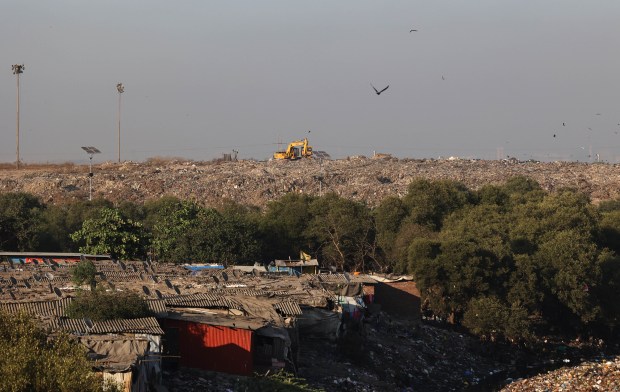
Models of hope
Indian cities stand at crossroads—reform waste management or risk environmental disaster. From behavioural changes to policy reforms, waste segregation to sustainable product design, the road ahead is challenging. But as experts emphasise, unless tough decisions are made now, the crisis will only deepen.
Singh of CSE identifies that in spite of variations, all successful waste management systems in cities like Indore, Pune, and Ambikapur have one thing in common—source segregation. For instance, according to a NITI Aayog’s ‘Waste-Wise City’ report, Indore, which is infrastructure-intensive, focused first on behavioural change by way of communication campaigns, followed by intense monitoring and by-laws. After segregation was attained, a study charted population and waste generation, resulting in an efficient collection strategy. “The success of Indore’s waste management derives first and foremost from its success in achieving 100% segregation of waste at source into six categories. Door-to-door collection of segregated waste is possible in every city, town and village of India as long as the local governing bodies are committed to it,” it further says on the aspect of replicability of the model.
Chhattisgarh’s Ambikapur, which was earlier suffering from waste dumping, implemented the ‘Garbage Clinic Model’. Local administration and women self-help groups ensured 100% segregation, collection, and processing. The waste is taken to the Solid and Liquid Resource Management Centre, where the recyclables are first extracted into 20 inorganic fractions by secondary segregation, followed by 156 categories in the tertiary segregation. The legacy waste dumpsite, which was cleared earlier, is now a recycling centre.
Pune has achieved 95% segregation with self-help groups such as SWaCH Seva Sahakari Sanstha Maryadit and Kagad Kach Patra Kashtakari Panchayat. The report says from 2008, Pune Municipal Corporation’s source segregation scheme has helped the informal sector to the extent that waste-pickers have been able to access quality non-biodegradable waste, improving income and efficiency.
“Common to all these case studies is that they all engage citizens in waste management. They’ve invested in behaviour change campaigns and are now seeing the rewards,” adds Singh of CSE.
